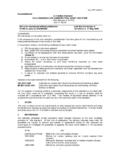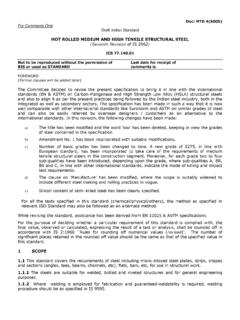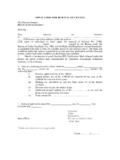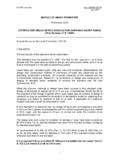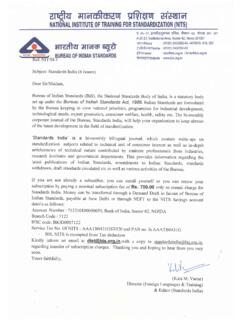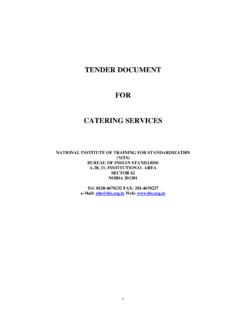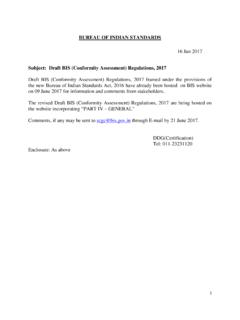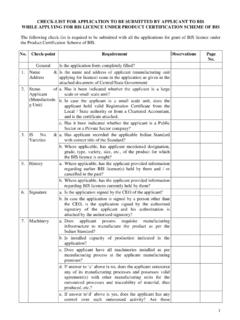Transcription of STUCTURAL STEELS FOR BUILDINGS AND …
1 7 Doc: MTD 4(4923) For Comments Only BUREAU OF INDIAN STANDARDS Modified Draft Indian Standard STUCTURAL STEELS FOR BUILDINGS AND STRUCTURES WITH IMPROVED SEISMIC RESISTANCE ICS ; Not to be reproduced without the permission of Last date for receipt of BIS or used as STANDARD comments is 15 June 2009 FOREWORD (Formal clauses will be added later on) For the purpose of deciding whether a particular requirement of this standard is complied with, the final value, observed or calculated, expressing the result of a test or analysis, shall be rounded off in accordance with IS 2:1960 `Rules for rounding off numerical values (revised) . The number of significant places retained in the rounded off value should be the same as that of the specified value in this standard. 1 SCOPE This standard covers the requirements of steel plates, shapes and sections (angles, tees, beams, channels etc.)
2 , flats, bars etc., for use in structural work. These STEELS are suitable for welded, bolted and riveted structures. When welding is employed for fabrication and guaranteed weldability is required, welding procedure should be as specified in IS 9595. Structural steel produced by re-rolling finished products such as plates and rails (virgin or used or scrap), or by rolling material whose metallurgical history is not fully documented or not known, is not acceptable as per this Indian Standard. 2 REFERENCES The standards listed below contain provisions, which through reference in this text constitute provisions of this standard. At the time of publication, the editions indicated were valid. All standards are subject to revision and parties to agreements based on this standard are encouraged to investigate the possibility of applying the most recent editions of the standards indicated below: IS No.
3 Title 228 (in various parts) Method for chemical analysis of steel 808:1989 dimensions for hot rolled steel beam, column, channel and angle sections (third revision) 1173:1978 Hot rolled slit steel tee bars (second revision) 1252:1991 Hot rolled steel bulb angles dimensions (first revision) 1599:1985 Method for bend test (second revision) 1608:2005 Metallic Materials- Tensile testing at ambient temperature (third revision) 81730: 1989 steel plates sheets , strips and flats for structural and general engineering purposes (second revision) 1731:1971 dimensions for steel flats for structural and general engineering purposes (first revision) 1732:1989 dimensions for round and square steel bars for structural and general engineering purposes (first revision) 1757:1988 Method for Charpy impact test (V-notch) for metallic material (second revision) 1852:1985 Rolling and cutting tolerances for hot-rolled steel products (fourth revision) 1863:1979 Hot rolled steel bulb flats (first revision) 1956(in various parts) Glossary of terms relating to iron and steel (in various parts) 2314:1986 steel sheet piling sections (first revision) 3803(Part 1):1989 steel Conversion of elongation values: Part 1 Carbon and low alloy STEELS (second revision) 3954:1991 Hot rolled steel channel sections for general engineering purposes (first revision) 8910:1978 General technical delivery requirements for steel and steel products 9595:1996 Metal arc welding of carbon and carbon manganese STEELS Recommendations (first revision) 10182 :( Part 1): 1982 dimensions and tolerances for hot rolled track shoe sections: Part 1 Sections TS IS 10182 :( Part 2).
4 1985 dimensions and tolerances for hot rolled track shoe sections: Part 2 Sections TS 10842:1984 Testing and evaluation procedure for Y groove crackability test 12457:1988 Code of practice for evaluation repairs and acceptance limits of surface defects in steel plates 12778:1989 dimensions for hot rolled steel parallel flange beam and column sections 3 Terminology For the purpose of this standard, the following definitions in addition to those given in the relevant parts of IS shall apply. Micro-Alloying Elements Elements, such as niobium, boron, vanadium and titanium added singly or in combination to obtain higher strength to weight ratio combined with better toughness, formability and weldability as compared to unalloyed steel of similar strength level. Weldability A metallic substance is considered to be weldable by a given process and for the given purpose, when metallic continuity to a stated degree can be obtained by welding using a suitable procedure, so that the joints comply with the requirements specified in regard to both their local properties and their influence on the construction of which they form a part.
5 Controlled Rolling A hot rolling process in which the temperature of the steel and its reduction ratio are controlled, particularly during the final rolling passes, in order to achieve fine grain micro structure and optimum mechanical properties. Normalising Rolling A hot rolling process in which the final rolling passes are carried out at a suitable higher temperature, followed by cooling in natural air to a temperature below the transformation temperature, in order to produce a structure, analogous to that obtained by a separate normalizing treatment of hot rolled product. 4 Supply Of Material General requirements relating a supply of structural steel shall conform to IS 8910. 5 Grades There will be six grades as given in Table1 & 2. Table 1 Chemical Composition Grade C max. Mn max. P max. S max. Si max. Cu max. Ni max. Cr max. Mo max.
6 CE E250S E300S E350S E450S E550S E600S NOTES 1. Carbon equivalent (CE) based on ladle analysis = C + (Mn)/6 + (Cr+Mo+V)/5 + (Ni+Cu)/15 2. All grades of steel will be fully Al-killed ( Total Al content shall not be less than percent). 3. Micro-alloying elements like Nb, V, Ti and B, shall be added singly or in combination and shall not be more than upto E450S and for E550S and above. 4. Alloying elements such as Cr, Ni, Mo and Cu shall be added singly or in combination and shall not be more than agreed between the purchaser and the manufacturers, the limitation of alloying elements other than those given in the table can be applied.
7 Content of steel shall not exceed percent, which shall be ensured by the manufacturer by occasional check analysis. However for grades E 550 S and E 600 S maximum value of nitrogen does not apply in case microalloying elements (Nb, V, Ti) exceeds 7. The steel if required may be treated with rare earth element for better formability. 8. Lower limits for carbon equivalent and closer limits for other elements may be mutually agreed to between the purchaser and the manufacturer. Table 2 Mechanical Properties YS, MPa, min. Grade <20 mm 20-40 mm >40 mm UTS, MPa min. YS / UTS max. % El. GL= So Charpy V-Notch Impact Energy, Min,J at 0oC E250S E300S E350S E450S E550S E600S 250 300 350 450 550 600 240 290 330 430 530 580 230 290 320 420 520 570 410 440 490 570 650 730 23 22 22 20 14 12 27 27 27 27 20 20 10 6 Manufacture The processes used in the steel making and further hot rolling into steel plates, sections, flats, bars, etc, are left to the discretion of the manufacturer/ supplier.
8 If required, secondary refining may follow steel making, as also normalizing rolling/controlled rolling during manufacturing or as the agreement between the purchaser and the manufacturer/supplier. 7 Freedom From Defects All finished steel shall be well and cleanly rolled to the dimensions , sections and masses specified. The finished material shall be reasonably free from surface flaws; laminations; rough/jagged and imperfect edges and all other harmful defects. Minor surface defects may be removed by the manufacturer/supplier by grinding provided the thickness is not reduced locally by more than 4 percent below the minimum specified thickness. Reduction in thickness by grinding greater than 4 percent but not exceeding 7 percent may be made subject to mutual agreement between the purchaser and the manufacturer/supplier.
9 8 Chemical Composition Ladle Analysis The ladle analysis of the steel , when carried out by the method specified in the relevant parts of IS 228 or any other established instrumental/chemical method, shall be as given in Table 1. In case of dispute, the procedure given in IS 228 and its relevant parts shall be the referee method and where test methods are not specified shall be as agreed to between the purchaser and the manufacturer/supplier. Product Analysis The product analysis shall be carried out on the finished product from the standard position. Permissible limits of variation in case of product analysis from the limits specified in Table 1 shall be as given in Table 3. 9 Selection and Preparation of Test Samples The position from which test samples are taken shall be so located in the product as to yield the clearest possible information regarding properties in the cross- sectional and longitudinal planes.
10 The recommended locations for taking test samples for plates, sections and bars are indicated in Alternatively, in case of sections, the samples may be taken from the web. For testing of flat products like plates tensile test pieces may be cut in the transverse direction. Selection of location of test pieces may also be mutually agreed between the purchaser and the manufacturer/supplier. Wherever practicable, the rolled surface of the steel shall be retained on the two opposite sides of the test samples. In case of flat test samples for tensile test, both surfaces are normally to be left on the test samples for plates up to 32 mm thick. At least one rolled surface shall be left on rectangular test samples taken from plates exceeding 32 mm thickness. Round test samples are permitted, but should only be adopted for thickness exceeding 20 mm. In case of flats up to 16 mm thick, the test samples shall undergo, if possible, no machining whatever, prior to use as a test piece.
